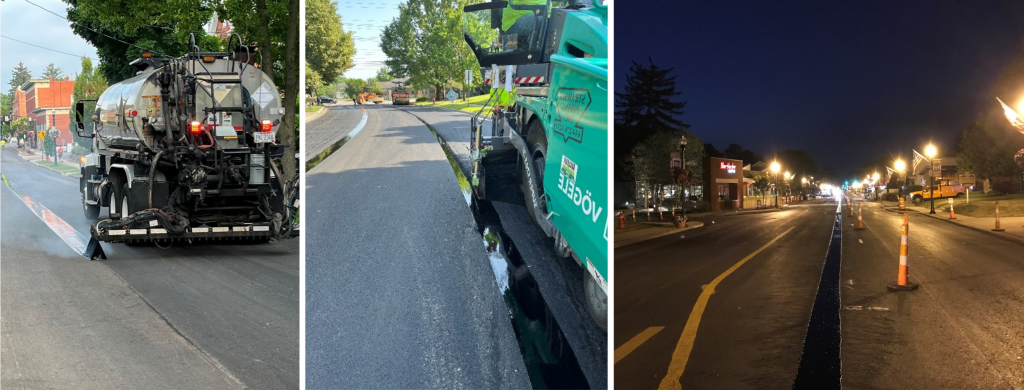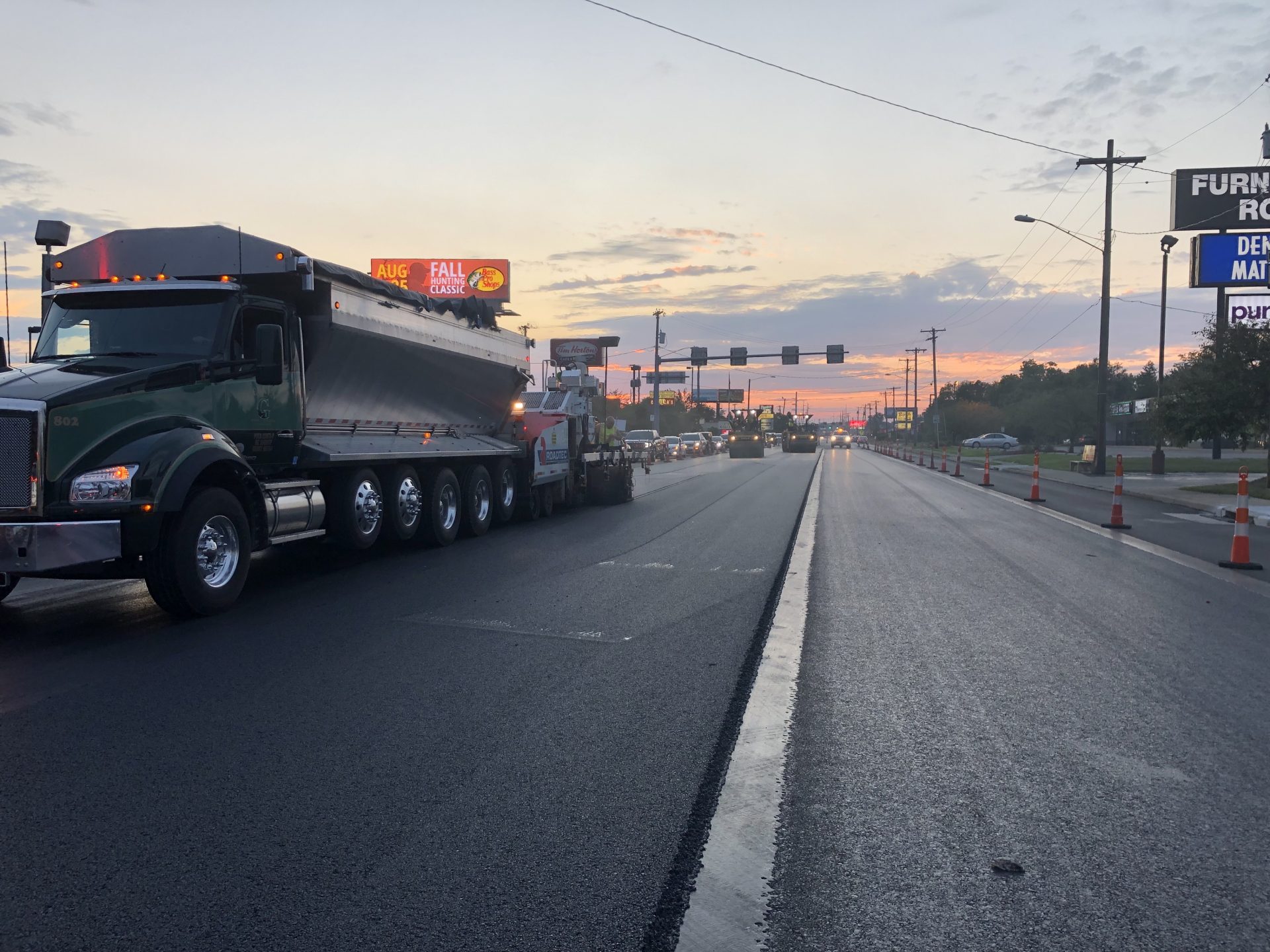As cities across the U.S. grapple with aging infrastructure and rising maintenance costs, two Ohio cities—Toledo and Westerville—are addressing both challenges by incorporating J-Band®, a Void Reducing Asphalt Membrane (VRAM), into their road network plans. J-Band not only slows pavement deterioration; it also stretches budgets, making it a smart investment for communities seeking long-term value.
Toledo and Westerville stand out for sustaining use of J-Band VRAM. Each city has completed dozens of projects using J-Band, as part of doing the job right the first time. Their goal is simple: build longer-lasting roads, reduce failure rates, and deliver better value for taxpayers.
What Is J-Band and Why Does It Matter?
Longitudinal joint failure is one of the most common and costly problems in asphalt pavements. These joints, where two paving passes meet, are prone to water and air infiltration, which accelerates cracking and deterioration. Traditional joint-sealing methods are typically reactive and often applied after damage has occurred.
J-Band VRAM solves this problem at the source. The material is designed to fill the air voids in the pavement, resulting in a longitudinal joint area that will last as long as the rest of the paving mat. Applied beneath the surface of where the joint will be, heat and pressure from paving operation causes the VRAM to migrate up and fill voids from below.
Key Benefits of VRAM:
- Extended Pavement Life: Adds 3–5 years to the lifespan of roads.
- Decreased Expense: Agencies save at least $2 in deferred maintenance cost for every $1 invested in VRAM.
- Reduced Maintenance: Minimizes the need for crack sealing and patching.
- Improved Safety: Fewer work zones mean fewer disruptions and safer roads for drivers and workers alike.
Unique Cities, Shared Commitment
Toledo, located in northwest Ohio with a population of over 260,000, serves as a regional hub with strong ties to the Great Lakes. Westerville, by contrast, is a suburban city northeast of Columbus with around 40,000 residents and is home to Otterbein University.
Despite differences in size and character, both cities share a forward-thinking mindset when it comes to infrastructure. They have actively embraced innovative technologies and built long-term strategies that prioritize road durability and fiscal responsibility.
Both municipalities stay engaged through industry organizations like the Ohio Transportation Engineers Conference (OTEC) and Flexible Pavements of Ohio’s Paving Conference. Their leaders understand that investing in prevention pays off and that innovation is not optional in today’s infrastructure landscape.
Toledo: Scaling Innovation Across a City
Toledo’s Engineering and Construction Management Division is comprised of about 60 employees who oversee all new road construction and resurfacing for the city. They began using VRAM in 2018 and have since completed 50 VRAM-enhanced projects, mainly on major roadway resurfacing and reconstruction projects with large traffic volumes. Today, J-Band is integrated into their repaving workflow, including off-season training sessions for crews to reinforce best practices.
Tim Grosjean, Senior Professional Engineer for The City of Toledo shared, “Toledo has been struggling with pavement joints for years as it has always been the first place our roads fail. Our first introduction to J-Band was at an asphalt conference, and we wanted to try it right away on numerous downtown streets.”
“We were interested in the idea of strengthening the joints from the bottom, and we also liked the flexibility of applying it prior to paving while still allowing traffic to drive over it. As an added bonus, we appreciate that ODOT recognizes the product benefits and is therefore eligible for reimbursement with State and Federal grant-funded projects. We have been pleased with the product so far and will continue to use it in our major road network.”
Toledo is a prime example of the value of a sustaining VRAM program, city-wide, especially in high-traffic, multi-lane environments. The Engineering and Construction Management Division plans to continue including VRAM in plan proposals for all major arterial projects.

Toledo, OH: Michigan & Erie Streets, 2018 – Monroe Street, 2019 – Perrysburg Holland Road, 2019
For more, explore this five-year project review of Toledo’s busy Erie Street.
Westerville: A Suburban Success Story
Westerville repaves about 8 to 20 streets per season, including city roads, residential areas, and streets surrounding Otterbein University. After completing their first J-Band project in 2019, they have since made VRAM a standard feature in most resurfacing projects—averaging 25,000 linear feet of VRAM in the last few years and completing about 70 projects to date. As more roads are reinforced with VRAM, the city is gaining service life, which stretches its budget further.

Westerville, OH: College Avenue, 2023 – Ashford Drive, 2022 – N. State Street, 2020
Why It Matters
The adoption of J-Band by cities like Westerville and Toledo highlights a shift in how municipalities approach infrastructure investment. Rather than reacting to failures, these cities are planning for longevity—a strategy that pays off in reduced costs, fewer disruptions, and more sustainable urban development.
Broader Implications:
- Economic: Lower long-term costs free up funds for other infrastructure needs.
- Environmental: Less frequent repaving reduces emissions and material waste.
- Scalable: J-Band can be adopted by cities of all sizes, making it a practical solution nationwide.
Smart Stewardship in Action
By prioritizing proactive treatments like J-Band, Westerville and Toledo demonstrate what smart infrastructure planning looks like. Their approach strengthens both pavements and the communities that rely on them.
In a time of tight budgets and high expectations, every road dollar counts—and these cities are making the most of theirs. Roads may not make the headlines, but fewer cracks, smoother drives, and reduced maintenance costs speak for themselves.
Want to learn more about how cities are building better roads with J-Band?
Let’s get in touch to discuss your roads > Contact – J-Band

